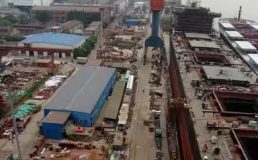COUNTERING LIGHTS, DIR. YINAN DING (1982)
Jiangnan Shipyard, Shanghai, China
The film ‘Countering Light’ is released in 1982, tells the story of the male protagonist breaking through the obstacles of secular thinking and class solidification, and finally falling in love with the female protagonist in the background of China’s reform and opening-up policy. In this era of rapid development of modern civilization, many traditional architectures still exist, such as the poor shantytowns (1842) (demolished in 2020) in Shanghai. While the Jiangnan Shipyard stands out as the only modern industrial building featured throughout the film.


Left: The manager of Jiangnan Shipyard showered the girls around the factory for the first time. Counter Lights 1982, directed by Yinan Ding
Right: The shantytown where the male protagonist lives is very dilapidated, with all houses, close together. Counter Lights 1982, directed by Yinan Ding
Jiangnan Shipyard, where the male protagonist works, originated in 1865 as the Jiangnan Manufacturing Headquarters to manufacture guns and munitions on ships (Liu 1983, 31). Since the reform and opening-up, Jiangnan Shipyard has entered a new period of rapid development with its technology reaching the advanced international level. It could not be better for the scriptwriters Su Ping to use it as a metaphor for the new age. Because the shipyard has a large area, I choose three representative sites. The first site is the crane in the shipyard. The director used the upshot angle to make us feel that the crane was taller than the reality. To contrast with the crane, however, is the shantytown, in which the male character lives is a product of a bygone era, formed by the influx of immigrants which lasted a century (Rao 2014, par. 2). The low, crowded houses (high angle shot) contrasted sharply with the majestic crane (low angle shot). However, what the author wants to express more is the collision between the feudal ignorance of the old era and the open mind of the new generation. It also foreshadows that the male protagonist meets his love in the shipyard.


Left: The girl wants to accost the male protagonist for the first time, but she keeps following him quietly because of shyness. Counter Lights 1982, directed by Yinan Ding
Right: Recent Jiangnan Shipyard from above, compared with the left image.
The left above picture is where the male and female protagonist first have a conversation, and it is the second site I will introduce. I found a recent photo of the exact location where the road is very spacious with no iron climbing frame in the middle. As the largest shipyard in China at the time, the director chose such a narrow site for ‘ulterior’ motives. On the lane where only two people can pass, it is hard not to let the audience resonate with the female protagonist of her nervous mood and imagine what will happen next under that tense atmosphere.
When the male protagonist falls in love with the heroine, he realizes that the lack at this particular time is ideological construction rather than infrastructure. He gave up his work in the shipyard into popular science education. When saying goodbye to his master in the shipyard, which is the last site I will introduce, the director Yinan Ding used a montage technique in which he did not directly shoot the dialogue between the protagonist and his master. Instead, he shot two workers waving goodbye. The worker looked down on the other and went higher and further. It suggests that the male protagonist moves towards a more glorious cause by using a towering image of the shipyard.

A worker ascends slowly in a machine, waving hands and saying goodbye to the workers below. Counter Lights 1982, directed by Yinan Ding
NOTES:
- Produced by the Zhu Jiang Film Studio, the film was directed by Yinan Ding and starred Chinese actors Guo Kaimin, Wu Yuhua, and Liu Xinyi.
- In 3rd China Golden Rooster, the film wins the award of the best photography and best music(nominated)
- Yongjian Liu, History of Jiangnan Shipyard (Jiangsu: Jiangsu Renmin Press, 1983), 31, http://mjlsh.usc.cuhk.edu.hk/PDFs/B/b25.pdf
- Fujie Rao, “城市史: 从棚户区的历史看其实质.” 澎湃新闻. Accessed February 27, 2022. https://www.thepaper.cn/newsDetail_forward_1261933.
- Modern images source: https://www.baidu.com/sf/vsearch?pd=image_content&word=江南造船厂&tn=vsearch&sa=vs_tab&lid=12305499716197303367&ms=1&from=844b&atn=page&fr=tab
—- FANG YIQUN
3033093222
You have demonstrated a high level of fieldwork research to understand the setting. You have also analyzed the relationship between the story and the setting, by understanding various film techniques. It would be great if you could adopt concepts we have discussed in class to anchor your piece.